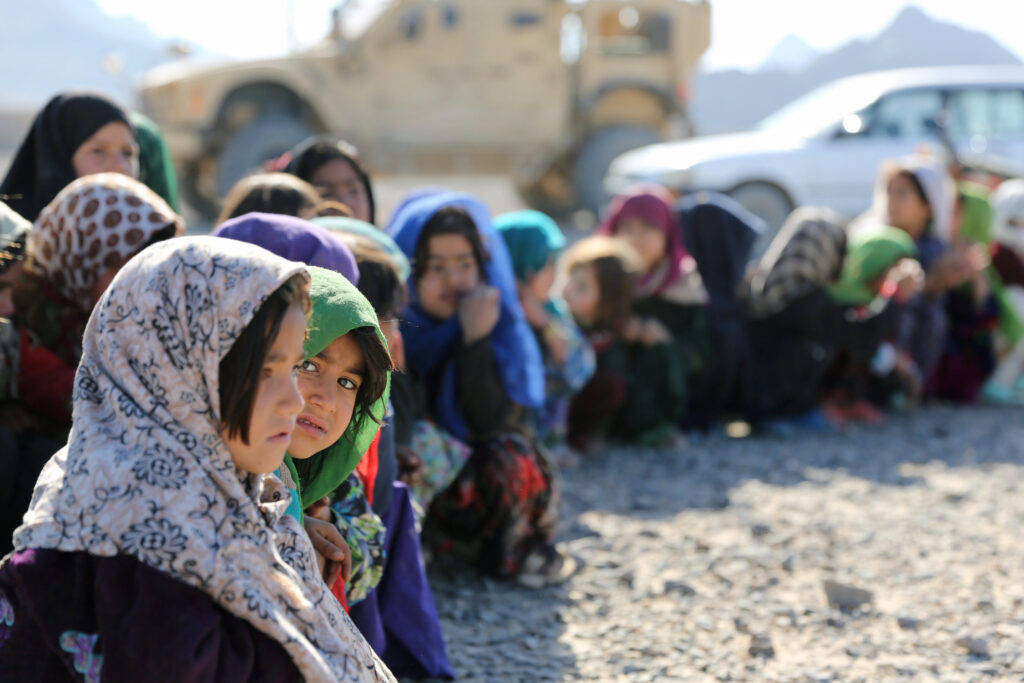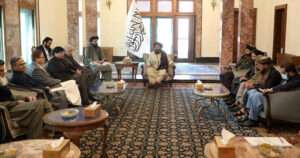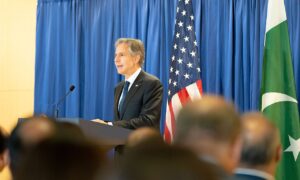Pakistan’s National Security Policy 2022 and the U.S. Department of State’s 2023 budget justification to Congress indicate both states’ clear intent to move past their security-centric bilateral engagement, which has been historically heavily focused on Afghanistan.1Government of Pakistan, National Security Division, “National Security Policy 2022-2026,” https://dnd.com.pk/wp-content/uploads/2022/01/National-Security-Policy-2022-2026.pdf; Government of United States, Department of State, “Congressional Budget Justification: Appendix 1,” (Washington, D.C., 2022), https://www.state.gov/wp-content/uploads/2021/07/FY-22-CBJ-A1-Full-Book-Final-as-of-07092021.pdf, 52. Following the U.S. withdrawal from Afghanistan in August 2021, the U.S. has redirected its assistance to Pakistan towards clean energy, women’s empowerment, entrepreneurship, and agricultural and commercial development. Post-withdrawal, however, the situation in Afghanistan has only worsened, with an estimated 24 million Afghans in need of humanitarian assistance and terrorist groups like ISKP gaining operational momentum.2“Afghanistan Refugee Crisis Explained,” (Washington, D.C.: USA for UNHCR, July 18, 2023), https://www.unrefugees.org/news/afghanistan-refugee-crisis-explained/; Abdul Sayed and Tore Hamming, “The Growing Threat of the Islamic State in Afghanistan and South Asia”, USIP, June 7, 2023. https://www.usip.org/publications/2023/06/growing-threat-islamic-state-afghanistan-and-south-asia. Afghanistan’s conflict environment still poses significant security risks for its neighbors, particularly Pakistan.
Since the Taliban takeover of Kabul, over 600,000 Afghan migrants and refugees have entered Pakistan.3Amel Ghani, “Pakistan steps up crackdown on Afghan refugees, adds new restrictions,” The New Humanitarian, 23 March, 2023, https://www.thenewhumanitarian.org/news-feature/2023/03/23/pakistan-crackdown-afghan-refugees. If Pakistan continues its ad-hoc refugee policies without increased donor support and assistance for third-state settlement, the already-precarious situation is likely to become a crisis. Economic growth in financial year 2023 has dropped from 2 percent to a projected 0.29 percent, so there is little hope for Pakistan’s stressed public sector to provide refugees with proper housing, livelihood, education, and health facilities.4Asif Shahzad and Ariba Shahid, “Pakistan set for 0.29% GDP Growth in FY23,” Reuters, June 8, 2023, https://www.reuters.com/markets/asia/pakistan-gdp-growth-seen-029-fy23-economic-survey-2023-06-08/.
The Afghan Taliban have repeatedly fired across Pakistan’s newly-fenced western border. In erstwhile Federally Administered Tribal Areas (ex-FATA), the Tehrik-i Taliban-i Pakistan (TTP) is resurging at the same time as the Islamic State Khorasan (IS-K) conducts transnational operations in the region. This policy memo highlights the value of continued U.S.-Pakistan cooperation on Afghan refugees and migrant management to prevent further risks of spillover effects related to instability in Afghanistan.
Registration of Afghans in the Absence of Domestic Refugee Laws in Pakistan
Pakistan has been hosting Afghan refugees for half a century, despite having no domestic refugee laws. Since conflict in Afghanistan arose in the 1970s, Pakistan has been the preferred destination for migrants and refugees fleeing protracted conflicts, militancy, and Afghanistan’s struggling wartime economy. In a 2021 survey of Afghans reaching Pakistan, 93 percent of respondents mentioned war and insecurity as reasons to flee Afghanistan.5K. M. Mielke et al, “Figurations of Displacement in and beyond Pakistan: Empirical findings and reflections on protracted displacement and translocal connections of Afghans (TRAFIG working paper 7),” (Bonn: BICC, 2021) https://doi.org/10.5281/zenodo.5841876. Khyber Pakhtunwa has absorbed the majority of Afghan refugees,6“Pakistan Map Registered Afghan Refugees April 30, 2021,” (Pakistan: UNHCR, 10 May 2021), https://data2.unhcr.org/en/documents/details/86559. due to deep ethnolinguistic and cultural ties.7Abubakar Siddique and Azmat Ali Shah, “The Lucky Few: Pakistani Citizenship Still Elusive For Most Afghan Refugees,” Radio Free Europe, 9 July, 2023, https://www.rferl.org/a/pakistan-citizenship-afghanistan-refugees/32495680.html. The travel route has also become a trade and transit point between both states, which have experienced an increase of 17.9 percent in annual exports from 2003 to 2020.8“Pakistan/Afghanistan,” Observatory of Economic Complexity, https://oec.world/en/profile/bilateral-country/afg/partner/pak#:~:text=Historical%20Data&text=(%2456.9M).-,During%20the%20last%2017%20years%20the%20exports%20of%20Afghanistan%20to,exported%20%24870M%20to%20Afghanistan. Additionally, some Afghan refugees use Pakistan as a route to resettle or seek asylum in a third state.9Nick Paton Welsh, “Afghans awaiting US resettlement say they’re being deported from Pakistan back to the Taliban,” CNN, July 28, 2023, https://edition.cnn.com/2023/07/28/asia/afghanistan-pakistan-taliban-us-visas-intl-cmd/index.html.
Despite the popularity of travel between Afghanistan and Pakistan, processes for migration, travel, and resettlement are poorly institutionalized. The lack of institutionalized processes, coupled with ex-FATA’s weak administrative capacity, has made it difficult to distinguish between Afghan economic migrants, itinerants, refugees, and militants traveling across the border to Pakistan.
Pakistan has not introduced any domestic refugee law or formal policy framework to manage Afghan migrations. Pakistan is not a signatory to the 1951 Refugee Convention and its 1967 protocol, which recognizes the rights of asylum and non-refoulment of refugees and forms key legal mandates of all UNHCR operations.10“Protection: asylum system in Pakistan,” (Pakistan: UNHCR), https://www.unhcr.org/pk/protection. Pakistan does not officially use the term “refugee” when registering Afghans and historically has granted informal refuge and economic access to Afghan migrants on a prima facie, humanitarian basis, as opposed to an established domestic structure. While arrivals from Afghanistan before 2006 registered with Pakistan’s government under the Proof of Registration (PoR) or Afghan Citizen Card (ACC) categories, ACC cards expired in 2018 and have not been updated since.11Mudassar Javed, CEO Society for Human Rights and Prisoners’ Aid SHARP – Pakistan, in discussion with author, Jan 2023. Instead, upon arrival in Pakistan, it is an Afghan migrant’s own responsibility to access SHARP (UNHCR’s implementing partner) and other partner organizations to request asylum certificates from UNHCR, which usually takes months.
The lack of institutionalized processes, coupled with ex-FATA’s weak administrative capacity, has made it difficult to distinguish between Afghan economic migrants, itinerants, refugees, and militants traveling across the border to Pakistan.
As of January 2022, approximately three million Afghans were living in Pakistan, around 1.4 million of whom are (PoR) cardholders, and approximately 840, 000 (ACC) cardholders. 12“Pakistan, Situation of Afghan Refugees,” (Luxembourg: European Union Agency for Asylum, May 2022), https://data.europa.eu/doi/10.2847/613763, 22. PoR cardholders have access to donor funds through UNHCR, (especially in designated refugee camps where 31 percent of Afghans live)13Mielke et al., “Figurations of Displacement,” 4., can open bank accounts, have easier mobility compared to non-cardholders, and can access education and health services. PoR and ACC cardholders should be protected from refoulement. They have already gone through Refugee Status Determination (RSD) and come under the mandate of either UNHCR or Chief Commissionerate of Afghan Refugees (CCAR) in Pakistan. Both these categories, however, are subject to status renewal every few years, via massive, coordinated exercises between UNHCR, CCAR and Pakistan government, which are frequently delayed.14Mielke et al., “Figurations of Displacement,” 10.
PoR cards that expired in June 2023 have not been updated yet; however, on July 20, 2023, the Ministry of States and Frontier Regions issued a special notification to Provincial and Federal governments against forcefully repatriating or detaining PoR or ACC holders. The option to renew these cards is available subject to an agreement update between UNCHR, Pakistan, and Afghanistan governments. The lack of clear policy on when or how the expired cards will be updated puts millions of registered Afghans at a risk of statelessness. Further, there are an estimated 775,000 Afghans living undocumented in Pakistan, who are liable for arrest, detention and deportation per the 1946 Foreigners Act.15“Pakistan, Situation of Afghan Refugees,” (Luxembourg: European Union Agency for Asylum, May 2022), https://data.europa.eu/doi/10.2847/613763.
Negative Implications of Ad-Hoc Afghan Refugee Management in Pakistan
Such ad hoc policymaking and implementation leaves Afghans who are undocumented or whose documents have expired vulnerable to deportation and arrest by local authorities, despite protections under international law against deporting refugees.
The lack of proper categorization of refugees and migrants, and Pakistan’s ad-hoc management of the refugee system, also results in the weakening of transit control mechanisms at the Pak-Afghan border. Torkham was blocked right after the Taliban takeover, and again in February 2023, on account of the sudden resurgence of TTP attacks in ex-FATA regions.16“Torkham border crossing between Afghanistan, Pakistan closed,” Al Jazeera, 20 February, 2023, https://www.aljazeera.com/news/2023/2/20/main-afghan-pakistani-border-crossing-closed-gunfire-reported. As a result, thousands of Afghans arrived at the Chaman border. Those arriving at Chaman were predominantly dealt with on humanitarian grounds; some were given access to KP on a tribal link basis, while others were turned back despite grave living conditions in Afghanistan.17Interview with border security personnel stationed near Torkham, May 2022.
A lack of legislative framework and legal mechanisms for Afghans in Pakistan has overburdened Pakistan as an underdeveloped state, resulting in competition for resources and political friction with host communities.18Kamal Khan, (Chief Coordinator, Chief Commissionerate of Afghan Refugees, Islamabad), in discussion with author, October 2022. (A team of RAHA officials joined the interview and revealed the motivation behind the program was to reduce friction with underdeveloped host communities with refugees being hosted by these communities.) UNHCR recently reported huge hurdles in integrating mostly unskilled Afghan refugees and migrants in Pakistan’s economic cycle.19“UNHCR DRIVE Report 2022- Pakistan Documentation Renewal and Information Verification Exercise Report,” (Pakistan: UNHCR, 27 September, 2022, https://reliefweb.int/attachments/b0c60ecb-de98-46e5-971b-d28274c83094/DRIVE%20Report.pdf.
Post-Withdrawal: The Current Situation
Third-country settlement appears unlikely for Afghan refugees in Pakistan, despite provision in international law. As of February 2023, the United Nations reports that 251,000 Afghans have approached UNHRC Pakistan for registration and asylum requests since August 2021,20“Afghanistan Situation Update – 1 February 2023,” (Pakistan: UNHCR, 6 February, 2023), https://data.unhcr.org/en/documents/details/98620 which will require USD $176 million in funds to resource in fiscal year 2023.21“Pakistan Funding Update 2023,” (Pakistan: UNHCR, 20 July, 2023), https://reporting.unhcr.org/pakistan-funding-2023. Of that figure, 43 percent is currently funded by donor states, including USD $16.2 million by the United States. Since withdrawal, the U.S. has processed roughly 84,600 Afghan refugees through Operation Allies Welcome.22“Operation Allies Welcome Announces Departure of All Afghan Nationals from U.S. Military Bases,” Department of Homeland Security, February 19, 2022, https://www.dhs.gov/news/2022/02/19/operation-allies-welcome-announces-departure-all-afghan-nationals-us-military-bases. Many members of Congress have advocated for standalone legislation on Afghan refugees. Senators like Jeanne Shaheen and Lois Frankel have pushed bills on asylum for Afghans and humanitarian intervention in Afghanistan.23Congresswoman Lois Frankel, “Meng, Waltz, Frankel And Houlahan Introduce Bipartisan Legislation Affirming The Role Of The U.S. In Eliminating Sexual Violence In Conflict,” June 29, 2022, https://frankel.house.gov/news/documentsingle.aspx?DocumentID=3499. These have not yet passed, although amendments to resource and report on the Afghanistan crisis were successfully passed in the omnibus,24Robbie Gramer, “Bill That Would Provide Lifeline to Afghan Refugees Blocked in Congress,” 20 December, 2022, https://foreignpolicy.com/2022/12/20/afghanistan-refugees-afghan-adjustment-act-congress-omnibus-bill/. and appropriations acts.25Extending Government Funding and Delivering Emergency Assistance Act of 2022, Division C—Afghanistan Supplemental Appropriations Act, https://www.govinfo.gov/content/pkg/COMPS-16551/pdf/COMPS-16551.pdf.
In June 2022, the Pakistani government approved a new transit visa for Afghans who had already been granted a third-country settlement,26APP/NewsDesk, “PM Shehbaz gives nod to new transit visas for Afghans,” Tribune, June 11, 2022, https://tribune.com.pk/story/2361073/pm-shehbaz-gives-nod-to-new-transit-visas-for-afghans. though most Afghans in Pakistan do not plan to settle in a third country.27Mielke et al., “Figurations of Displacement,” 9.Around 30 families requesting for third-state settlement have not been entertained by foreign embassies (mostly US and European) and have settled in illegal camps near Press Club Islamabad as a form of protest.28Interviews with Afghan refugee families camped near Press Club Islamabad. Dec 2022.
There is no consensus on whether to repatriate or integrate those Afghans living in Pakistan, what kind of policy should be adopted for new arrivals, and whether the PoR cards’ validity should be extended.
Despite political inertia and implementation challenges, Pakistan has had some developments in its policies towards Afghan migrants. The government eased access for Afghan traders to cross checkpoints.29Web Desk, “Cabinet approves changes in policy for Afghan transporters,” The News, June 28, 2022, https://www.thenews.com.pk/latest/969911-cabinet-approves-changes-in-policy-for-afghan-transporters. Multiple entry visas for visit or business purposes were introduced in the current visa policy for Afghans, enacted in 2020. There has been little disclosure, however, of the tax laws, trade facilitation, and long-term economic integration offered to these traders.
As for new arrivals seeking asylum in Pakistan, Pakistan’s Ministry of State and Frontier Regions (SAFRON) in Pakistan has denied access to all previous forms of registration under either the PoR or ACC scheme. SAFRON has also barred UNHCR from issuing asylum certificates, insisting that the state cannot further the burden of the health and education sectors. At present, there is a stalemate between the Pakistan government, UNHCR, Afghan Taliban, and refugee groups. There is no consensus on whether to repatriate or integrate those Afghans living in Pakistan, what kind of policy should be adopted for new arrivals, and whether the PoR cards’ validity should be extended.
Policy Recommendations and Possible Redirections
UNHCR had intervened as a major implementing partner for Afghan refugee management. In 2011-2021, UNHCR, together with the Pakistani government, implemented more than 4,260 projects (67% in Khyber-Pakhtunkhwa) in education, water, sanitation, health and livelihood.30“RAHA Factsheet,” (Pakistan: UNHCR, April 2021), https://www.unhcr.org/pk/wp-content/uploads/sites/103/2021/04/RAHA-Factsheet.pdf. In June 2022, the government of Pakistan, in partnership with UNHCR, completed a massive verification of registered 1.3 million refugees, updating their data for the first time in ten years. This enabled the government to assess the need for donor assistance and facilitate repatriation.31“Government, UNHCR verify 1.3 million Afghan refugees in Pakistan,” (Pakistan: UNHCR, 3 June, 2022), https://www.unhcr.org/pk/13933-government-unhcr-verify-1-3-million-afghan-refugees-in-pakistan.html.
Given Pakistan’s current political, economic and security situation, the government needs assistance to manage the pull factors including porous borders and an extension of informal asylum at community levels that are independent of state supervision.
The U.S, is the largest donor of UNHCR Pakistan operations.32“Donor Ranking,” UNHCR, https://reporting.unhcr.org/dashboards/donor-ranking?year=2023. The 2022 congressional budget included USD $82.8 million for Afghanistan and Pakistan operations, centered on security and Afghan refugee management. Stability of Pak-Afghan border regions especially in ex-FATA, economic growth, increased trade, and women empowerment are highlighted in the request.33Government of United States, Department of State, “Congressional Budget Justification: Appendix 1,” (Washington, D.C., 2022), https://www.state.gov/wp-content/uploads/2021/07/FY-22-CBJ-A1-Full-Book-Final-as-of-07092021.pdf, 52. Better U.S. coordination with the Pakistani government, UNHCR, USAID and UNODC are needed to increase efficiency. Humanitarian response demands provision of services in education, health & nutrition, livelihoods, protection, clean water, and sanitation. While those residing at RVs or carrying PoRs have access to these services under UNHCR projects like RAHA, greater coordination is needed to expand access of these services to all refugees independent of cardholding status and improve the registration process to document refugees and regularize refugee management systems.
As collaborative partners on Afghan refugee management, both states’ relevant institutions need to agree and clearly communicate long-term goals around Afghan refugee and migrant management. This could lead to the development of a legal framework, and implementation mechanisms, for internationally recognized solutions to this issue. The U.S. may consider diversifying its humanitarian aid portfolio for Afghan refugees in Pakistan, in conjunction with UNHCR and the government of Pakistan.
Regularizing visa status of Afghans in Pakistan
Pakistan needs to pass refugee laws to transparently manage transit across the Pak-Afghan border and to sustain the Afghans registered and settled in Pakistan. The refugee coordinator at the U.S. Embassy could engage key stakeholders and facilitate a dialogue on existing policy gaps, their costs and responsive refugee related legislation. The key stakeholders may include US and Pakistan governments, UNHCR, INGOs, donor states, and Afghan government representatives. Such a dialogue may also help Pakistan adopt a long-term strategy for Afghan refugee management around internationally acceptable solutions of repatriation, third state settlement, or systematic integration and also help Pakistan access a wider donor pool.
Facilitating such dialogue could help the U.S. ascertain the efficiency and feasibility of assistance funds allocated for Afghan refugees in Pakistan, humanitarian assistance, and even development funds for ex-FATA. The stakeholders to be engaged from Pakistan may include Pakistan’s Ministry of State and Frontier Regions (SAFRON), National Assembly Standing Committee on Human Rights, Senate Committee on Law and Justice, leaders from KP, and representatives from border security forces to identify common goals on security, economy and people-to-people contact between Afghanistan and Pakistan.
Introduce a visa category for economic migrants from Afghanistan, to facilitate swift visa processing upon arrival. The U.S. Institute of Peace is working on small projects in Pakistan to train women entrepreneurs that may be extended to Afghan refugee and migrant women. Pakistan’s Ministry of State and Frontier Regions (SAFRON), Ministry of Trade and Commerce (which already has a transit and trade agreement signed with Afghanistan), and the Foreign Office of Pakistan could help implement such measures.
The U.S. could help Pakistan access a wider pool of donor funds for newly arrived Afghan migrants and refugees, on the condition that Pakistan implements refugee regularization via legislation, offer refugees better access to public utilities, and guarantee basic rights like education and health.
UNHCR and USAID could conduct trainings to build the capacity of border security professionals for more transparent transit control, in conjunction with the Pakistan government charting a formal transit policy allowing for movement of refugees and economic migrants across the newly fenced border.
Easing pressure on Pakistan by settling refugees elsewhere
The U.S. government may consider facilitating third-state settlement of Afghans from Pakistan, under the Biden Administration’s policy of adopting 125,000 refugees from across the globe in 2023.34Camila Montoyo-Gavilez, “U.S. to retain 125,000 cap on refugee admissions for fiscal year 2023,” CBS News, 9 September, 2022, https://www.cbsnews.com/news/us-2023-refugee-cap-125000/.
No donor state nor Pakistan can sustain millions of refugees indefinitely. However, Pakistan government has no accurate data on the actual costs and corresponding budget requirement for hosting or repatriation. The U.S. can engage with organizations like UNAMA, Agency Coordinating Body for Afghan Relief & Development (ACBAR) Afghanistan Research and Evaluation Unit (AREU) and UNHCR to help Pakistan government to accurately assess needs and perform a situational analysis with the aim of drawing up a systematic repatriation program for refugees.
Cooperation and information sharing
In its recent budget, the U.S. earmarked funds for developing the districts in ex-FATA that were integrated into Pakistan in 2018. The U.S. should deploy assistance funds in coordination with KP’s provincial assembly, union council members, and district administration. The U.S. does not see the TTP and ISK-P as imminently likely to launch transnational attacks, but helping the newly-merged ex-FATA districts with economic, administrative and security reform may help reduce the recruitment potential of terrorist organizations in the region.
Due to the lack of centralized migration data, Pakistan’s security and administrative apparatus has been unable to assess the true costs or benefits of the porous Afghan border to Pakistan’s economy and security. The U.S. Embassy in Pakistan, could reconcile yearly goals and year-end progress of funds released via INGOs (USAID, UNDP, UNODC, UNHCR) and assistance made to Pakistan’s government via PRM or DoD, for security, development and refugee management across Pak-Afghan border terrain. This may address any disconnect between security and humanitarian goals and achieve synergy in operations that are being funded by US government across Pak-Afghan border terrain.
Stimson South Asia Program Visiting Fellows represent a diversity of perspectives and experience. As members of a term academic program, their writing and views do not necessarily represent those of the South Asia program or of the Stimson Center.
Notes
- 1Government of Pakistan, National Security Division, “National Security Policy 2022-2026,” https://dnd.com.pk/wp-content/uploads/2022/01/National-Security-Policy-2022-2026.pdf; Government of United States, Department of State, “Congressional Budget Justification: Appendix 1,” (Washington, D.C., 2022), https://www.state.gov/wp-content/uploads/2021/07/FY-22-CBJ-A1-Full-Book-Final-as-of-07092021.pdf, 52.
- 2“Afghanistan Refugee Crisis Explained,” (Washington, D.C.: USA for UNHCR, July 18, 2023), https://www.unrefugees.org/news/afghanistan-refugee-crisis-explained/; Abdul Sayed and Tore Hamming, “The Growing Threat of the Islamic State in Afghanistan and South Asia”, USIP, June 7, 2023. https://www.usip.org/publications/2023/06/growing-threat-islamic-state-afghanistan-and-south-asia.
- 3Amel Ghani, “Pakistan steps up crackdown on Afghan refugees, adds new restrictions,” The New Humanitarian, 23 March, 2023, https://www.thenewhumanitarian.org/news-feature/2023/03/23/pakistan-crackdown-afghan-refugees.
- 4Asif Shahzad and Ariba Shahid, “Pakistan set for 0.29% GDP Growth in FY23,” Reuters, June 8, 2023, https://www.reuters.com/markets/asia/pakistan-gdp-growth-seen-029-fy23-economic-survey-2023-06-08/.
- 5K. M. Mielke et al, “Figurations of Displacement in and beyond Pakistan: Empirical findings and reflections on protracted displacement and translocal connections of Afghans (TRAFIG working paper 7),” (Bonn: BICC, 2021) https://doi.org/10.5281/zenodo.5841876.
- 6“Pakistan Map Registered Afghan Refugees April 30, 2021,” (Pakistan: UNHCR, 10 May 2021), https://data2.unhcr.org/en/documents/details/86559.
- 7Abubakar Siddique and Azmat Ali Shah, “The Lucky Few: Pakistani Citizenship Still Elusive For Most Afghan Refugees,” Radio Free Europe, 9 July, 2023, https://www.rferl.org/a/pakistan-citizenship-afghanistan-refugees/32495680.html.
- 8“Pakistan/Afghanistan,” Observatory of Economic Complexity, https://oec.world/en/profile/bilateral-country/afg/partner/pak#:~:text=Historical%20Data&text=(%2456.9M).-,During%20the%20last%2017%20years%20the%20exports%20of%20Afghanistan%20to,exported%20%24870M%20to%20Afghanistan.
- 9Nick Paton Welsh, “Afghans awaiting US resettlement say they’re being deported from Pakistan back to the Taliban,” CNN, July 28, 2023, https://edition.cnn.com/2023/07/28/asia/afghanistan-pakistan-taliban-us-visas-intl-cmd/index.html.
- 10“Protection: asylum system in Pakistan,” (Pakistan: UNHCR), https://www.unhcr.org/pk/protection.
- 11Mudassar Javed, CEO Society for Human Rights and Prisoners’ Aid SHARP – Pakistan, in discussion with author, Jan 2023.
- 12“Pakistan, Situation of Afghan Refugees,” (Luxembourg: European Union Agency for Asylum, May 2022), https://data.europa.eu/doi/10.2847/613763, 22.
- 13Mielke et al., “Figurations of Displacement,” 4.
- 14Mielke et al., “Figurations of Displacement,” 10.
- 15“Pakistan, Situation of Afghan Refugees,” (Luxembourg: European Union Agency for Asylum, May 2022), https://data.europa.eu/doi/10.2847/613763.
- 16“Torkham border crossing between Afghanistan, Pakistan closed,” Al Jazeera, 20 February, 2023, https://www.aljazeera.com/news/2023/2/20/main-afghan-pakistani-border-crossing-closed-gunfire-reported.
- 17Interview with border security personnel stationed near Torkham, May 2022.
- 18Kamal Khan, (Chief Coordinator, Chief Commissionerate of Afghan Refugees, Islamabad), in discussion with author, October 2022. (A team of RAHA officials joined the interview and revealed the motivation behind the program was to reduce friction with underdeveloped host communities with refugees being hosted by these communities.)
- 19“UNHCR DRIVE Report 2022- Pakistan Documentation Renewal and Information Verification Exercise Report,” (Pakistan: UNHCR, 27 September, 2022, https://reliefweb.int/attachments/b0c60ecb-de98-46e5-971b-d28274c83094/DRIVE%20Report.pdf.
- 20“Afghanistan Situation Update – 1 February 2023,” (Pakistan: UNHCR, 6 February, 2023), https://data.unhcr.org/en/documents/details/98620
- 21“Pakistan Funding Update 2023,” (Pakistan: UNHCR, 20 July, 2023), https://reporting.unhcr.org/pakistan-funding-2023.
- 22“Operation Allies Welcome Announces Departure of All Afghan Nationals from U.S. Military Bases,” Department of Homeland Security, February 19, 2022, https://www.dhs.gov/news/2022/02/19/operation-allies-welcome-announces-departure-all-afghan-nationals-us-military-bases.
- 23Congresswoman Lois Frankel, “Meng, Waltz, Frankel And Houlahan Introduce Bipartisan Legislation Affirming The Role Of The U.S. In Eliminating Sexual Violence In Conflict,” June 29, 2022, https://frankel.house.gov/news/documentsingle.aspx?DocumentID=3499.
- 24Robbie Gramer, “Bill That Would Provide Lifeline to Afghan Refugees Blocked in Congress,” 20 December, 2022, https://foreignpolicy.com/2022/12/20/afghanistan-refugees-afghan-adjustment-act-congress-omnibus-bill/.
- 25Extending Government Funding and Delivering Emergency Assistance Act of 2022, Division C—Afghanistan Supplemental Appropriations Act, https://www.govinfo.gov/content/pkg/COMPS-16551/pdf/COMPS-16551.pdf.
- 26APP/NewsDesk, “PM Shehbaz gives nod to new transit visas for Afghans,” Tribune, June 11, 2022, https://tribune.com.pk/story/2361073/pm-shehbaz-gives-nod-to-new-transit-visas-for-afghans.
- 27Mielke et al., “Figurations of Displacement,” 9.
- 28Interviews with Afghan refugee families camped near Press Club Islamabad. Dec 2022.
- 29Web Desk, “Cabinet approves changes in policy for Afghan transporters,” The News, June 28, 2022, https://www.thenews.com.pk/latest/969911-cabinet-approves-changes-in-policy-for-afghan-transporters.
- 30“RAHA Factsheet,” (Pakistan: UNHCR, April 2021), https://www.unhcr.org/pk/wp-content/uploads/sites/103/2021/04/RAHA-Factsheet.pdf.
- 31“Government, UNHCR verify 1.3 million Afghan refugees in Pakistan,” (Pakistan: UNHCR, 3 June, 2022), https://www.unhcr.org/pk/13933-government-unhcr-verify-1-3-million-afghan-refugees-in-pakistan.html.
- 32“Donor Ranking,” UNHCR, https://reporting.unhcr.org/dashboards/donor-ranking?year=2023.
- 33Government of United States, Department of State, “Congressional Budget Justification: Appendix 1,” (Washington, D.C., 2022), https://www.state.gov/wp-content/uploads/2021/07/FY-22-CBJ-A1-Full-Book-Final-as-of-07092021.pdf, 52.
- 34Camila Montoyo-Gavilez, “U.S. to retain 125,000 cap on refugee admissions for fiscal year 2023,” CBS News, 9 September, 2022, https://www.cbsnews.com/news/us-2023-refugee-cap-125000/.




